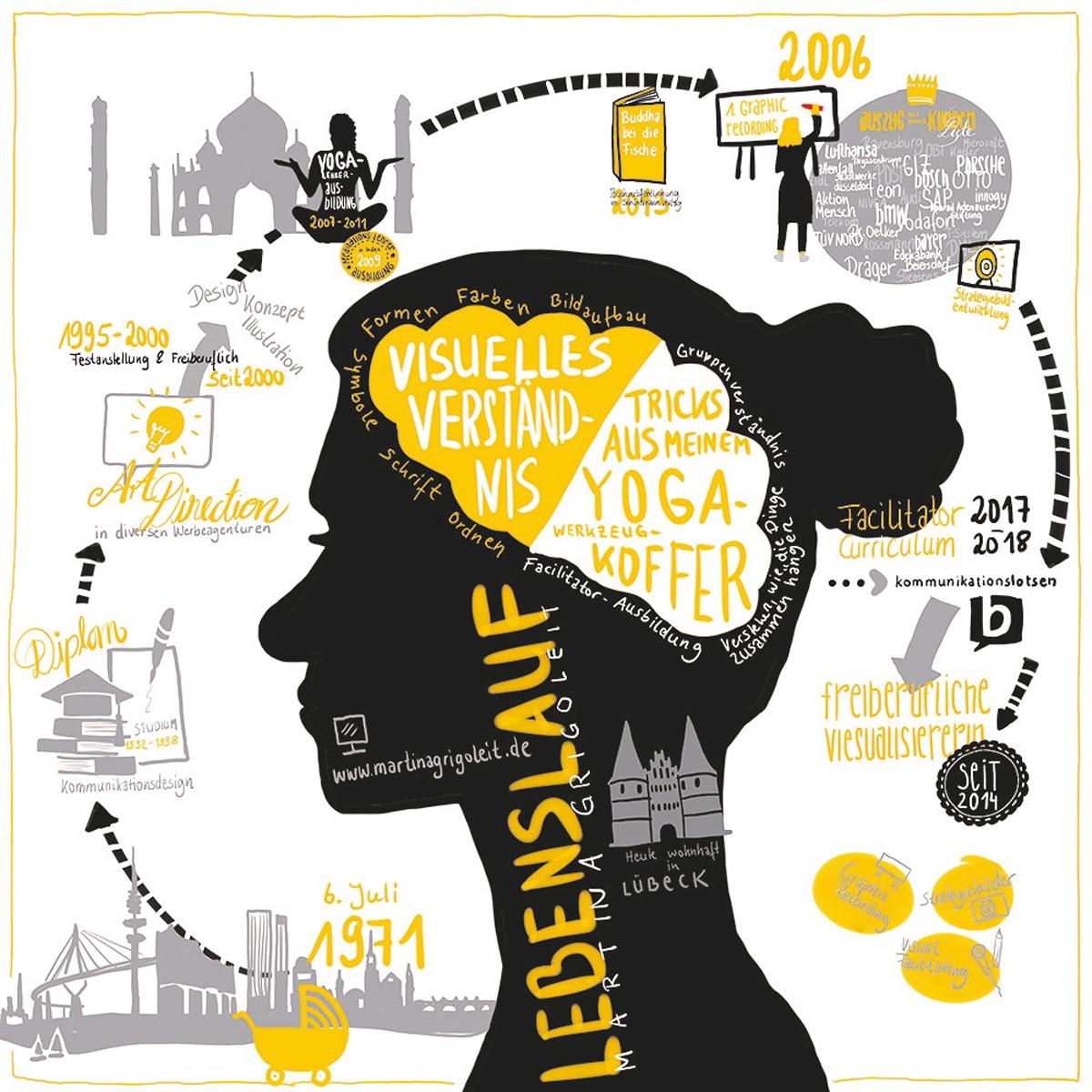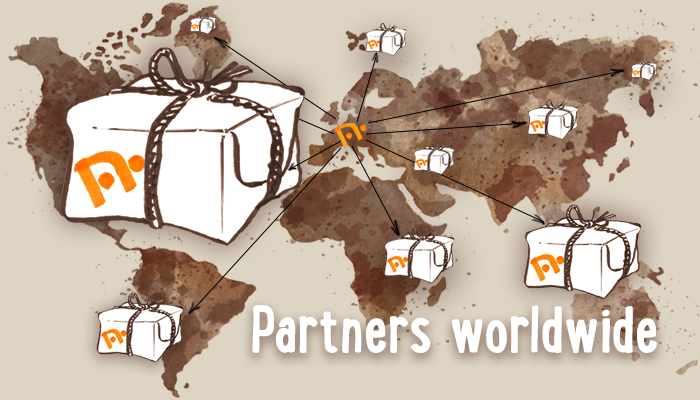Graphic Recording is one of the most challenging methods in the field of visualization. We talked to Martina Grigoleit, a German Graphic Recorder, to share everything you might wanna know about this exciting topic.
It seems like Martina Grigoleit has worked as a Graphic Recorder since forever. After studying communication design, she worked as a designer and illustrator in marketing for a long time. It’s hard to believe but this was 25 years ago. Back then she already liked to think outside the box, became a yoga instructor on the side and eventually a full-time Graphic Recorder. Today she’s a successful author and shows how to combine her passion of visualization with yoga.

Martina, we all know you’re a pro now but how did you actually become a Graphic Recorder?
Back in the days, I used to attend innovation workshops. You can imagine it like that: Someone wanted to invent a new chocolate bar and I was drawing how this could look. One day, Andreas Gärtner contacted me and told me about something he had seen on the internet. Back then almost nobody knew what Graphic Recording was and he wanted to give it a try … And that was the first time I did it. It was 16 years ago and the recording I created was unbelievably ugly and not structured at all. But somehow nobody knew better, we did neither and nor did our client.
It’s great to see what has evolved out of an idea like this! What skills should someone have who wants to do this job?
For me, there are two directions you have to bring together. On one side, there’s creativity and drawing. On the other side facilitation and consulting. You should be able to screen information, decide what’s important and what isn’t, ask the right questions, and guide your clients through the process. These two different areas are combined and, depending on the job, one of the two might be more important than the other. But ideally you should have both skills.

And if I feel like I can do this, how do I get started? Are there any special courses?
Nowadays there are a lot of courses you can attend. There are basic introductory courses for visualization where you learn how to create sketchnotes with basic shapes. From there you can upskill, for instance with a training in the field of facilitation. In my opinion it’s super easy to piece together the workshops relevant to you. When it comes to visualization I myself offer a couple of workshops, too. But at some point you just have to jump and do the job.
I guess it’s difficult to overcome your fears at first, isn’t it?
Definitely. But you don’t have to do everything on your own, you can get help, find a coach. I also supervise newbies when they have to prepare for a job. I teach them how to interact with clients, which information they should get out of their conversations … A personal coaching is a great way to get started.
Martina’s workshops are in German but she speaks English and can be booked for English events, too. Feel free to drop her a message.

We’ve talked about the skills of a Graphic Recorder already. Is there anything else that’s important?
I think it’s courage. You will reach this point where you just have to jump in at the deep end. It doesn’t matter if it’s online or in-person, you’re on stage and there are always loads of people looking over your shoulder. You have to have the guts to do that and not everyone is made for this kind of job.
And everything else one might wanna know is probably included in your book. It’s only available in German but there might be English readers who are interested in it as well.
You’re right, my book is about Graphic Recording, or live visualization because it’s actually very extensive. My aim was to look at the topic from different angles. It’s a perfect handbook for someone who wants to do this job.
I don’t just explain what Graphic Recording is (which is pretty interesting for clients, too, by the way), I also talk a lot about the difference between Graphic Recording and Visual Facilitation, or other areas you could use your skills in. And I talk about prices and calculations. Life’s so much easier with clarity and transparency. I also put my prices on my website. This way, everyone knows exactly what s/he can expect.
By the way: Here’s an extract of Martina’s book.

Another thing you’re very open about are “fuck-ups”. What’s the funniest thing that has ever happened to you?
There was a time when Graphic Recorders were booked every day. I’m very organized, so I’ve always been well-prepared. One day, I was driving to the event location to do a Graphic Recording and I had to realize that there was nobody there. Nobody at all. You know, my biggest fear is that I mix up the locations and on that day I thought it had happened. But it turned out I was just one day early. And that was actually pretty great because I had one whole day off. 🙂
You’re lucky you weren’t one day too late. 😀 After 16 years of experience, do you still get the jitters?
Always. It always starts with the fear of the white wall somehow. Since I’m very experienced, however, I know by now that it always works out. So, I’m more relaxed than I used to be and today I’m able to sleep the night before a gig.

I assume you also ask your client about an event’s agenda and topics discussed, right?
Of course. I’ve got a list with at least 30 questions to ask from the first call to the last. I bug my clients until I got all the information I need. 😉 I need to know the agenda and also if the focus is on facilitation or visualization, for instance.
What if it’s a topic you know nothing about?
Until now there hasn’t been a topic I couldn’t comprehend. Usually the client wants to get a look from the outside. For me, the most difficult topic was “new technologies in mining” and it was in English. In retrospect I ask myself how I did this. But there was no job so far where I actually needed to understand everything in detail. And most of the time, people actually talk more about how to work together than the topic itself. So, you don’t need to be an expert in mining.

Now that many events take place online, how has your work life changed?
Everything has changed. First of all, I don’t have to travel as much. And, of course, I draw more on my iPad now than I used to. But I still offer to work with analog tools. And many clients still prefer that because the desire to work with paper is still there, even in this digital world. Sometimes I feel like this desire is even getting stronger. At home I have a huge Neuland GraphicWall and I can simply aim my camera at it. And I also work a lot with small format paper and a camera, plus all my Neuland Markers, of course. 🙂

Do you also offer courses on this topic?
I do. I offer an online course on my book, where I describe which tools I use and how I use them. And I also offer short workshops and a two-day in-person training together with HanseLab in Lübeck.
You’ve already mentioned the tools you work with. Do you also have a favorite Neuland tool?
Actually I almost use all Neuland products. When it comes to markers, there’s not really an alternative to use anyway. But some tools I’d definitely count as my favorites. I obviously love the LW-X and the FatOnes. And I absolutely love two of the metallics, the silver one and the blue one. They are amazing to write on black.

Good choice! 😉 How did you become aware of Neuland in the first place?
Back in the days, I used Neuland without really thinking about it. And sometimes I posted pictures of my Graphic Recordings. In 2014 Guido contacted me on Facebook because he liked my work and told me to check out the EuViz event. Well, and this is the reason I went there in the first place. I’ll always be grateful that Guido contacted me. 😀 It was an absolute game changer for me. And this was the time when I got more and more gigs, too.
That’s so cool! On a more serious topic … Particularly creative people often have to deal with self-doubts. Do you have any tips on how to get motivated or overcome a creative block?
In my experience, you get a creative block when you wait too long to, when you think too much. My first tip is “Simply do it.”, so SIMPLY do it and simply DO IT, right now’s the best time. You can also get inspired by others but never copy. And since I’m also a yoga instructor I like to share some breathing techniques as well. Uncertainty often emerges from a fear of disappointing someone, or not being enough. Take a step back, sit down and focus on your breathe for 10 minutes to bring your attention back to yourself. Exhalate a little bit longer than you inhalate to calm down. I always do that when I feel like I’m not getting anywhere right now.
Wow, this interview is full of useful information on Graphic Recording. Thank you so much for taking the time, Martina, it was a pleasure!





